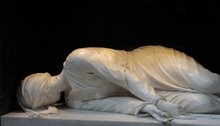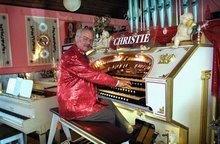THE PIPE-ORGAN IN THE MUSICAL ACADEMY OF SOFIA
The pipe-organ was built in 1979 by Jehmlich Orgelbau Dresden.
I. Hauptwerk - C-g3 .. II. Schwellwerk - C-g3, ... Pedalwerk - C-f1
Rohrflöte 8' .............. Gedackt 8' ................ Subbaß 16'
Prinzipal 4' ............... Weidenpfeife 8' ......... Prinzipalflöte 8'
Nasat 2 2/3' .............. Koppelflöte 4' ........... Gemshorn 4'
Waldflöte 2' .............. Prinzipal 2' ............... Mixtur 3f.
Mixtur 3-4f. .............. Terz 1 3/5' ............... Trompete 8'
Dulzian 16' ............... Quinte 1 1/3'
..............................Zimbel 2f. .........................
............................. Krummhorn 8' .................
............................. Tremulant ........................
Prinzipal 4' ............... Weidenpfeife 8' ......... Prinzipalflöte 8'
Nasat 2 2/3' .............. Koppelflöte 4' ........... Gemshorn 4'
Waldflöte 2' .............. Prinzipal 2' ............... Mixtur 3f.
Mixtur 3-4f. .............. Terz 1 3/5' ............... Trompete 8'
Dulzian 16' ............... Quinte 1 1/3'
..............................Zimbel 2f. .........................
............................. Krummhorn 8' .................
............................. Tremulant ........................
I/II, I/P, II/P
19 stops, slider chests, tracker tonе-action, mechanical stop action /draw stops/
The pipe-organ was originally installed on the side wall of .......
the Musical Academy concert hall. In 1993 the organ was moved by Petar Padev on the front wall, immediately behind the stage where it holds its ideal position from acoustics and atmosphere point of view. Despite the fact that the instrument was chiefly designed for educational purposes its project and sound reveal quite an interesting approach. It was created in the aesthetic pipe-organ building atmosphere of the middle to the 80-s of 20-th century. The strife for equally good capacity to perform both romantic-symphony music as well as baroque polyphony style has been most successfully accomplished. The stops possess the perfect ability to mix and form new sound nuances. What impresses is the delicate and refined way of interacting of the various stops in the horizontal and vertical position. 19 stops make for a full-blown pipe-organ but even if so the Principal-base of Grand, Swell and Pedal positioned in different hights to culminate in pyramid structure of 16', 8' and 4'. The same structure continues in the Mixtures with the highest Zimbel in the Swell-positif. Thus both Manuals leave enough space for a good number of Flute-stops - 7 Flute- and 1 String- stop /Weidenpfeife 8'/. The instrument also conaints a sufficient number of Mutations such as Nassat 2 2/3', Terz 1 3/5' and Quint 1 1/3' thus mixing the lower stops but also manifesting a distinct bright and timbre formative quality. This enables the superb effecting of counterpoint and imitation in baroque textures. The high Quint 1 1/3' there is an absolute necessity to create the pyramid structure and the harmonious prinzipal-boddy in Grand Pleno. It is curious to know that the 16' from the Reed-stops is not located in the Pedal but in the Grand Organ. In this way we have a well pronounced 8' Pedal reed-stop frequently applied in early and later baroque and similar to style of french baroque pipe-organs. On the other hand there is the 16' reed stop in the Manual which gives the good opportunity of performing full-bodied romantic textures. The ultimate result is that the Pedal in the Grand Pleno obtains the depth of Dulzian 16' with the coupler I/P and the instrument acquires the expected classical sound.
It has been 1 year already since I haven`t tended to this pipe-organ which is why I am not in the position to assess its state. One year ago there were small technical irregularities in the tone-trackers; the Tremulant hardly audible and as a whole losing part of its good tuning. These technical and sound imperfections are not major to impede performing or to harass the organ player. To the best of my knowledge I haven`t heard of any serious technical problems and it is my thinking it can be played at concert or rehearsals.
The pipe-organ was originally installed on the side wall of .......
the Musical Academy concert hall. In 1993 the organ was moved by Petar Padev on the front wall, immediately behind the stage where it holds its ideal position from acoustics and atmosphere point of view. Despite the fact that the instrument was chiefly designed for educational purposes its project and sound reveal quite an interesting approach. It was created in the aesthetic pipe-organ building atmosphere of the middle to the 80-s of 20-th century. The strife for equally good capacity to perform both romantic-symphony music as well as baroque polyphony style has been most successfully accomplished. The stops possess the perfect ability to mix and form new sound nuances. What impresses is the delicate and refined way of interacting of the various stops in the horizontal and vertical position. 19 stops make for a full-blown pipe-organ but even if so the Principal-base of Grand, Swell and Pedal positioned in different hights to culminate in pyramid structure of 16', 8' and 4'. The same structure continues in the Mixtures with the highest Zimbel in the Swell-positif. Thus both Manuals leave enough space for a good number of Flute-stops - 7 Flute- and 1 String- stop /Weidenpfeife 8'/. The instrument also conaints a sufficient number of Mutations such as Nassat 2 2/3', Terz 1 3/5' and Quint 1 1/3' thus mixing the lower stops but also manifesting a distinct bright and timbre formative quality. This enables the superb effecting of counterpoint and imitation in baroque textures. The high Quint 1 1/3' there is an absolute necessity to create the pyramid structure and the harmonious prinzipal-boddy in Grand Pleno. It is curious to know that the 16' from the Reed-stops is not located in the Pedal but in the Grand Organ. In this way we have a well pronounced 8' Pedal reed-stop frequently applied in early and later baroque and similar to style of french baroque pipe-organs. On the other hand there is the 16' reed stop in the Manual which gives the good opportunity of performing full-bodied romantic textures. The ultimate result is that the Pedal in the Grand Pleno obtains the depth of Dulzian 16' with the coupler I/P and the instrument acquires the expected classical sound.
It has been 1 year already since I haven`t tended to this pipe-organ which is why I am not in the position to assess its state. One year ago there were small technical irregularities in the tone-trackers; the Tremulant hardly audible and as a whole losing part of its good tuning. These technical and sound imperfections are not major to impede performing or to harass the organ player. To the best of my knowledge I haven`t heard of any serious technical problems and it is my thinking it can be played at concert or rehearsals.
--------------------------------------------------------------------
Kamen Petev , voxcellesta@gmail.com





No comments:
Post a Comment